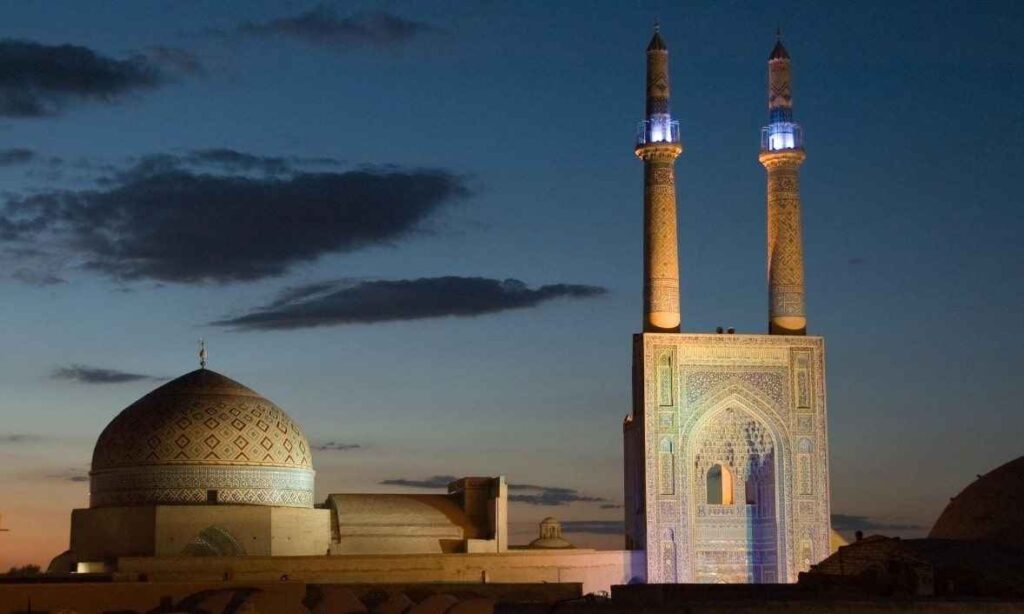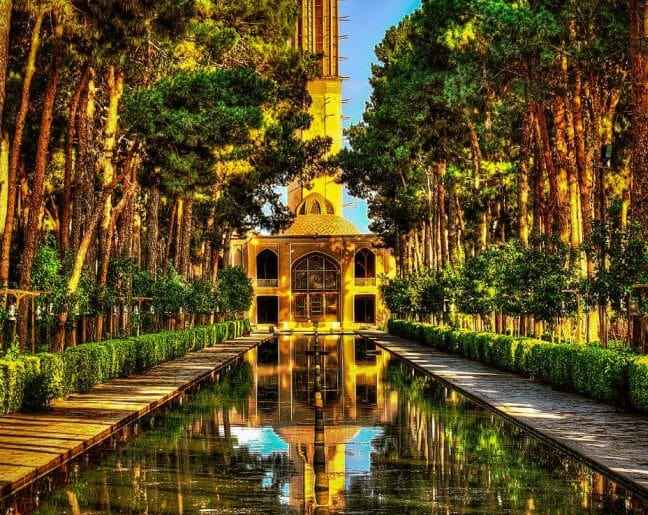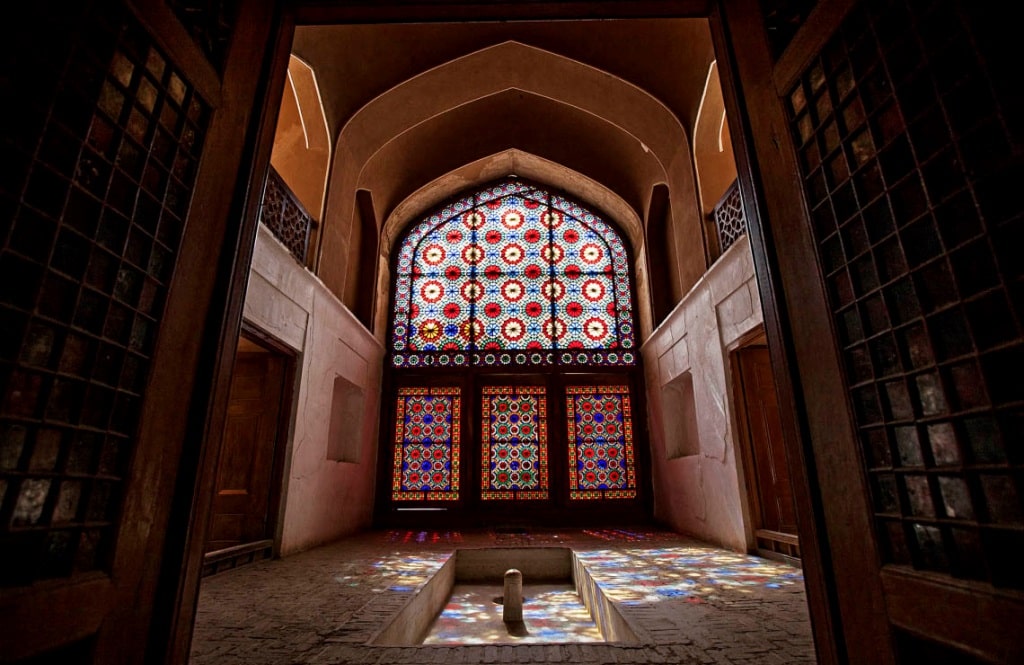Yazd Travel Guide Goes to the Heart of the City
In a flat plain covered with a fence of mountains, somewhere in the heart of the desert where the Desert Plains and Lut Plains give their light and warmth to the earth, a city is located. A city in which the aqueducts have taken the water that is the essence of life from the ground, the winged windbreakers dominated the wind and with the atmosphere on its alleyways, continue the life of this civilization with centuries of history. Yazd travel guide takes travelers to one of the oldest cities in Persia whose history goes back to ancient Persia. Where you figure out that history is within the people’s lifestyle. Visiting ancient places such as Dakhme, Silence Towers and Zoroastrian Fire Temple will take you deep into history, and walking through the old avenues of Fahadan. Visiting the tallest Windbreaker in Dowlat Abad Garden in the world. The garden is one of the world heritage sites that will spell you and take you deep into Shehrzad fairytales. Complex headings in Yazdi Cashmere; Classes filled with foods and desserts such as Baklava and Qutab served as a feast in the heart of the desert. A feast under the starry desert sky takes you deep into the stories of a thousand and one nights and completes your journey from Yazd.

History of Yazd
Yazd Travel Guide represents travelers to the city that dates back to before the third millennium BC. The presence of dynasties in the history of Yazd is clear to see, and some sources in history have attributed the antiquity of the early buildings of the important city of Yazd to the time of the Prophet Solomon, Alexander the Great, and so on. Historians consider Yazd to be the safest historical city in Persia due to its geographical location. The location has made Yazd safe from natural disasters, wars, and sudden historical changes. Yazd Travel Guide shows you the historical importance of Yazd in terms of preserving the traditional and historical context. The peak of Yazd’s prosperity in the eighth century was due to being located in the main trade routes of the time. Having textile and silk weaving industries the Atabakan county of Yazd was one of the most important factors in the development of the city. Also, Yazd has a prosperous economy compared to other cities of Persia.

Yazd Travel Guide Narrates Architecture of the City of Windbreakers
Yazd is the capital of Persian architecture at the heart of desert. The architecture of Yazd houses is a distinctive and delightful example of the structure of desert houses. The architecture is suitable for hot and dry climates in Iran. The intelligent people of Yazd were the first to discover “clay” by combining the four main elements of soil, water, fire, and wind. As well, with their unparalleled perseverance and hard work, they drew water from the heart of the arid land of the Yazd and invented the aqueduct. They have built brick palaces and houses and built a historic city with magnificent architecture. A city that, with its globalization, is not only a source of pride for the people of Iran. Our Yazd Travel Guide is supposed to tell you that why Yazd is a source of honor for our beloved Earth.
Yazd Historical City is a treasure trove of Persian art, culture, and civilization. All these heritage that Yazd Travel Guide takes us to are in religious buildings, mosques, Hosseiniyahs, tombs, Zoroastrian shrines, historical houses and gardens, windbreaks, water reservoirs and traditional markets of Yazd. Even the back alleys of its old neighborhoods are among the sights of Yazd. An outstanding example of the ancient and original architecture of Yazd has been observed in the “Fahadan” or “Yuzdaran” neighborhood. The area is also famous as the “Yuzdaran” forest or neighborhood in the local dialect. Yazd Travel Guide attracts your attention to Other important historical neighborhoods such as the Qala-e-Kohaneh neighborhood, Sar-e-Jama neighborhood, Sar-e-Do-Rah neighborhood, Yaghoubi neighborhood, Mosalla neighborhood, Lab-e-Khandagh neighborhood, etc.

Inspiring Titles of Yazd
Khajeh Nizam-ol-Molk Tusi called the pious city of Yazd “Dar al-aibadah”. The name became famous during the time of “Mohammad Taghi Falsafi” the famous contemporary Iran speaker. Due to the presence of large and well-equipped husseiniyehs, breastfeeding style, special lamentation, palm picking at noon of Ashura. Setting up the symbolic shrine of the third Shiite Imam gave Yazd the title of “Hosseinieh of Iran”. People renovate old houses in the historical context of Yazd and turning them into restaurants or hotels. Local people preserves this precious heritage as a Yazd travel guide, which has attracted the most interested and demand tourists and has become a traditional guest house. The historical city of Yazd has other various titles such as the city of windbreakers, the city of sweets, the city of bicycles. As well, philosophers call the city as Dar al-Abadah, Dar al-Alam, and Dar al-Amal. In addition, it is famous as the city of aqueducts and contentment, the city of fire and sun.
Yazd, City of Windbreaks
The historical city of Yazd has the largest number of windbreaks in Persia because each house used to have its windbreaker in the past so that is the reason why Yazd was named the city of windbreaks. Windbreaks are special to desert cities, especially Yazd because they convert the burning heat to cool and pleasant air. An unparalleled example of Yazd windbreaker engineering is the Dowlat Abad Garden windbreaker, which is the tallest windbreaker in the world and a sign of the genius of Yazdi architecture and is famous to the world. The architectural style of this 8-cornered, 280-year-old windbreak dates back to the Zandi and Qajar eras, which dates back to 1160 AH and is made of clay and brick by the order of “Mohammad Taghi Khan Bafghi”.

Yazd Travel Guide Directs You to Reconciliation Alleys
The reconciling alleys of Yazd are twisted alleys, which are located in the historical context of Yazd with high and brown walls, like a large network, that have traditional houses in their heart. Houses with wooden, large doors and with amazing knobs. These alleys are so narrow that it is usually difficult for two people to cross them. So that if two people have sulked with each other and something happens at the same time and in two opposite directions, they are forced to become one-sided, otherwise they will get stuck in the middle of the alley. This interesting situation, little by little, brings laughter to both person’s lips and leads to the removal of grudges.
Yazd Travel Guide Inspire You by Travelers Comments
Marco Polo visited Yazd in 1272 A.D and said: “Yazd is a good and original city and there is a lot of trade there.” They weave a specific silk called Yazdi / Yasdi, and the merchants send it to different places.”
“Hawks” a foreign explorer who had lived in Yazd for a short time, stated:” These days the merchants do not have the old boroughs in the city and some of the houses that belong to the merchants of Yazd, have become accommodations for tourists.
According to a Canadian tourist, “the old avenue of Yazd is one of the best places to explore and get lost; the narrow streets and the extraordinary greatness of the walls and the structure of the building are incredible.” Many of the houses are open and you can go in and take a look; some of them have windbreaks that you can go under it and experience real cooling without the use of electricity.”
Other Successes of the Brick City of Persia
The city of Yazd, with its ancient history, is located in the heart of Persia; this desert city has been considered by human beings from the past and has spent its whole life with ups and downs in the storm of events. To get acquainted with the religion of ancient Persia, you can visit the historical complex of Amir Chakhmagh, a monument from the Timurid era, and the charming Dowlat Abad Garden and its stunning windbreak known as the eight-sided windbreak.

Yazd Travel Guide, As a UNESCO World Heritage
Yazd is the only city in this land of Persia to be listed as a UNESCO World Heritage Site. The distinguishing point of Yazd’s historical context is the preservation of their tangible heritage of architecture and urban planning, along with keeping all their culture and customs alive. It is the architecture and urban planning structure that added the city of Yazd to the UNESCO World Heritage List in 2017.
UNESCO World Heritage Criteria of Yazd
Criterion (iii): The historical context of Yazd is a testament to thousands of years of living in the harsh desert environment. The city is built entirely of natural elements, and clever methods have been used to create a pleasant local climate within its buildings and neighborhoods, which are derived from the water from 130 aqueducts (Qanats) around the city. Its historic buildings include houses, mosques, fire temples, synagogues, tombs, baths, water tanks, schools, and markets. The aqueduct water supply system of this city (Qanat) is a cleaver urban water engineering, which from the 10th to the 20th century AD, caused a lot of settlements in Persian lands and is known as the civilization of aqueducts. Yazd aqueducts have the most skillful engineering design. The endowment social system, which is prevalent in Yazd, has led to the use of places such as water tanks, baths, and mosques in the public interest. This social process can be seen in the form of trade and handicrafts, the peaceful life of the followers of Islam, Judaism, and Zoroastrianism, and their rituals and ceremonies.
Criterion (v): The historical context of Yazd is a valuable example of the interaction between man and nature in the desert environment. The intelligent management of limited water resources by the aqueduct system and the use of natural elements in the construction of buildings are examples of this interaction. These buildings in Yazd include courtyards and basements. In addition to building a pleasant local climate and earthquake resistance, the minimal use of raw materials in the construction of this building has also inspired the builder in today’s world, which is facing the challenges of sustainable development.

Location of Yazd
Yazd is one of the central cities of Persia, which is located in a dry valley between the Shirkuh and Khoranagh mountains. From the north, this city leads to the cities of Meybod and Ardakan, from the east leads to Ardakan and Bafgh cities, from the west leads to Isfahan province, and from the south to Taft and Abarkuh cities.
Yazd Travel Guide Informs You How to visit the City
The city of Yazd, with its ancient history, is located in the heart of Persia; this desert city has been considered by human beings from the past and has spent its whole life in ups and downs in the storm of events. Dowlat Abad Garden and the most breathtaking windbreak in Yazd, known as the octagonal windbreak of Dowlat Abad Garden, also visit the peculiar mosque of Yazd and the Zoroastrian fire temple and Yazd burial mound to get acquainted with the religion of ancient Persia.
Where to Stay Near Yazd
Traditional Hotel of Fahadan
Yazd Museum of Fahadan is one of the 4 Mehr hotel Chains in Yazd, which is located in the heart of the back alleys of the historical fabric of Yazd. This ancient building is the first hotel – Museum of Persia and a relic of Qajar architecture. Mr. Sheikh Mehdi Arab, who was a carpet and undercover merchant, built this house about 250 years ago. It is at Fahdan Hotel in Yazd that by staying in it, you can experience the good feeling of traditional life in the land of clay and soil.
Zainuddin Caravanserai
It is one of the most beautiful caravanserais located in the heart of the deserts of Yazd province in Mehriz city. This caravanserai is located 60 km from Yazd-Kerman road and has been used as a tourist attraction these days as one of the unique buildings that have remained in this city since the Safavid period.
Nartiti Residence
It is a traditional place where guests, beyond accommodation, touch and experience a kind of indigenous and traditional life of the people of that city or village. Nar Titi or Pomegranate Blossom is the name of the first eclipse in Taft city with its traditional and nostalgic design. Features of this traditional house include green space and an orchard that guests can use for free.
4* Dad Hotel
4 * Dad Hotel is a historical building with traditional architecture and beautiful views in the heart of the old texture of Yazd city, which is located near historical and cultural monuments such as the Zoroastrian fire temple and the Amirchakhmaq complex. Among the tourist attractions of Yazd Dad Hotel, it is good to mention the Water Museum, Shash Badgiri Reservoir, Kuwaiti Bazaar, and Markar Square. While maintaining its traditional and historical structure, Dad Hotel has modern amenities, including modern multi-purpose halls, a traditional restaurant with a variety of delicious Persian and French dishes in a quiet and pleasant environment, and an outdoor coffee shop on the roof of the hotel overlooking Yazd. It is located near the health centers.
Dad Hotel is the only 4* hotel in Yazd that won the 2009 German Studious award for customer orientation.
Where to eat near Yazd
Abolmaali Restaurant
Located in the historic building of Abolmaali Bath, which dates back to the Qajar period, it presents one of the largest traditional restaurants in Yazd and serves a variety of Persian, Persian, and Arabic dishes.
Refugee Café
This 60-year-old restaurant is never closed at any time of the year and has a cozy and friendly atmosphere, and since this restaurant is located in Panja Ali Bazaar, you can come to this restaurant after sightseeing and special food. The café is a refugee shelter.
Mahour Restaurant
It has been opened in the old part of Yazd city. The 300-year-old building of this restaurant and its proximity to the historical monument of Amir Chakhmaq has doubled its popularity among tourists.
Mahour Restaurant Yazd
Restaurant Mahour is composed of a variety of traditional dishes and fast food. Its clean and brick atmosphere brings a sense of freshness to customers.
When to visit Yazd
Since Yazd is a desert region, it has a desert, hot and dry climate, so it is better to visit in the cool seasons of the year. Spring is also a relatively popular season in this historical city.
How to go to Yazd
Yazd is about 631 km from Tehran and you can try different ways to get there from the capital. If you drive a personal car, it takes about 6 and a half to 7 hours. The next option is to travel to this city by train or by buying a plane ticket.
Yazd Airport: The name of this airport is Shahid Sadoughi Airport(AZD), which is located 10 km from the city center, and with a direct flight from Tehran to Yazd, you can easily get to the city.
Near Imam Hossein Square in Yazd, there is a square called Rah-e-Ahan Square, where the railway station of the city is located. Through this station, you can access other cities of Yazd province and other parts of Persia.

